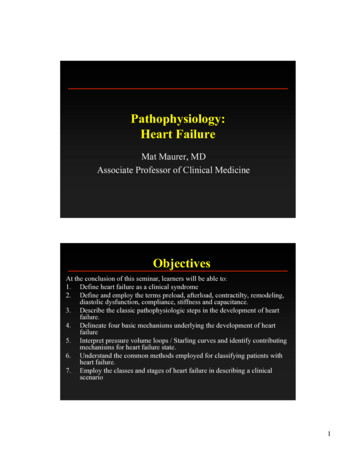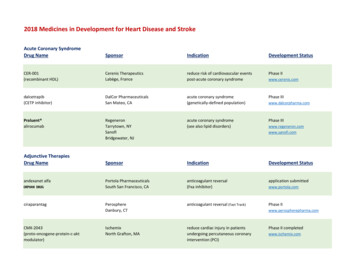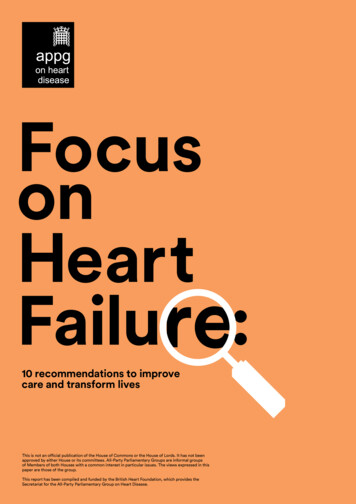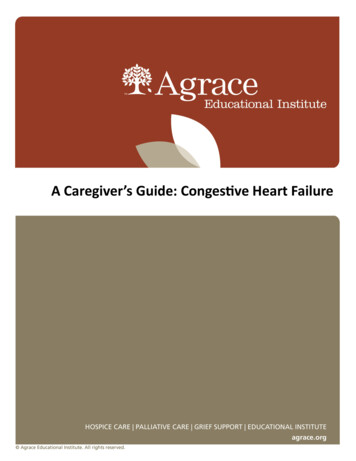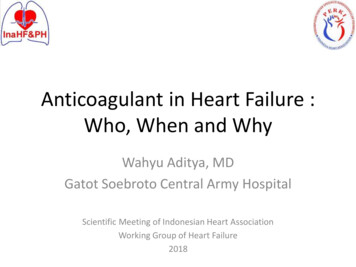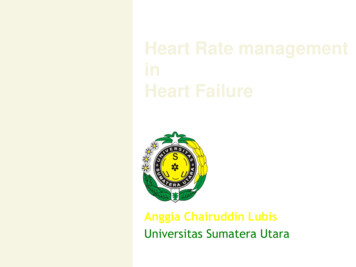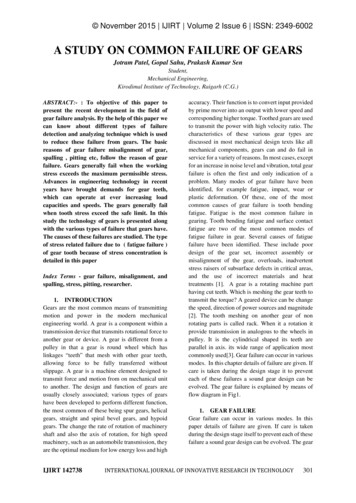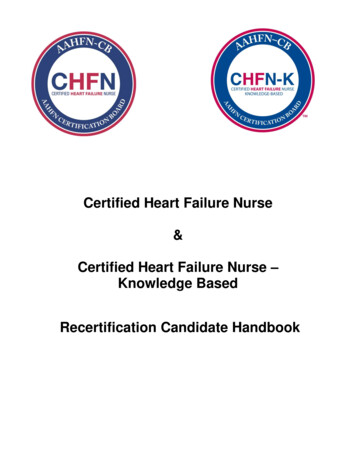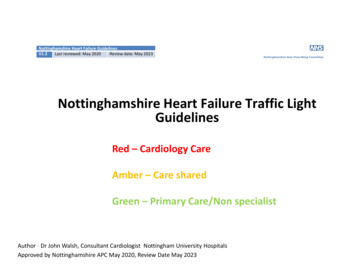
Transcription
Nottinghamshire Heart Failure GuidelinesV1.2Last reviewed: May 2020Review date: May 2023Nottinghamshire Heart Failure Traffic LightGuidelinesRed – Cardiology CareAmber – Care sharedGreen – Primary Care/Non specialistAuthor - Dr John Walsh, Consultant Cardiologist Nottingham University HospitalsApproved by Nottinghamshire APC May 2020, Review Date May 2023
The Heart Failure Nottinghamshire LightsScope and PurposeThe purpose of the Heart Failure Nottinghamshire Lights is to provide local clinical and service guidance for General Practitioners and practice-basedstaff on the management of people diagnosed with heart failure. The Heart Failure Nottinghamshire Lights supports the QIPP workstream on theintegrated care pathway for heart failure with recommended quality markers developed by the Nottinghamshire Coronary Heart Disease NetworkHeart Failure Group based on clinical evidence.The Nottinghamshire Heart Failure Lights denote the colours Green, Amber and Red which indicates the clinical/therapeutic and service classificationof patients’/carers journey along and between an integrated care pathway for heart failure and recommendations for treating heart failure (NICE2018). The heart failure traffic light classification is a simple means of classifying patients into the various potential health sectors delivering heartfailure, recognising that patients will move between the different sectors at different stages of their journey.PATIENTS MAY BE REFERRED DIRECTLY TO HEART FAILURE CLINICS AT NUH OR SFHGREEN – defines patients with a CONFIRMED aetiological diagnosis and clinically stable and/or no unscheduled heart failure admissions in previous6 months and on baseline medical therapy. Baseline medical therapy is defined by NICE and includes ACE inhibitors, beta blockers and diuretics. Inpatients intolerant of ACE inhibitors Angiotensin II receptor blockers (ARBs) are considered an alternative.GREEN PATIENTS MAY BE MANAGED IN PRIMARY CARE BUT CONSIDER REFERRAL TO A SPECIALIST FOR CONFIRMATION OFAETIOLOGY.AMBER – classify if clinically unstable patient and/or 1-2 unscheduled admissions in previous 6 months and taking intermediate medical therapy. Intermediate medical therapy will include patients intolerant of baseline therapy and those requiring spironolactone or eplerenone in addition to baselinetreatments. Ivabradine requires consideration in patients in sinus rhythm with heart rate 75 bts/minute and ejection fraction 35% despite treatmentwith beta blockers and optimal baseline therapy. Ivabradine may also be considered in patients intolerant of or unable to take betablockers. Considercessation of ACE inhibitors or ARB and switch to sacubitril/valsartan (Entresto ) in patients with LVEF 35% who remain symptomatic (NYHA II-IV).Consider dapagliflozin as an adjunct to standard therapy for patients who remain symptomatic on optimised standard care.AMBER PATIENTS WILL USUALLY NEED A COMBINED CARE APPROACH BETWEEN PRIMARY AND SPECIALIST CARE. THIS MAYINVOLVE THE HEART FAILURE MULTI-DISCIPLINARY TEAM WITH THE SUPPORT OF SPECIALIST HEART FAILURE NURSES.RED – classify if clinically unstable patient and/or more then 2 unscheduled heart failure admissions in the previous 6 months on advanced medicaltherapy. Advanced medical therapy consists of either digoxin (particularly for patients in AF) and/or an ARB and/or prescribed metolazone or bendroflumethiazide therapy added to baseline/intermediate therapy.RED PATIENTS SHOULD BE CONSIDERED FOR REFERRAL TO CONSIDER PALLIATIVE OR ADVANCED STRATEGIES E.G.BIVENTRICULAR PACING, DEFIBRILLATORApproved by Nottinghamshire APC May 2020, Review Date May 2023Page 2 of 15
GreenCLINICALStable with diagnosis confirmed by Echo,and/or no unplanned HF admissions in theprevious 6 monthsTHERAPYBaseline therapy: ACE or ARB if ACE intolerant orHydralazine with nitrate if ACE and ARBintolerance. Beta-blocker Diuretic (if fluid retention)AmberCLINICALUnstable and/or 1-2 unplanned HFadmissions in the previous 6 monthsTHERAPYIntermediate therapy: Failed baseline therapy or On-going baseline therapy ANDspironolactone or eplerenone added Consider addition of ivabradine for patientsin sinus rhythm, HR 75 beats per minuteand ejection fraction 35% Consider sacubitril/valsartan (Entresto ) Consider dapagliflozinRedCLINICAL / THERAPEUTIC CLASSIFICATIONCLINICALUnstable and/or 2 unplanned HF admissionsin the previous 6 months, advanced care orpalliation to be consideredTHERAPYAdvanced therapy: Addition of digoxin if AF or on-goingsymptoms despite intermediate therapy Addition of ARB to intermediate therapy Thiazide therapy required in addition toloop diureticsSERVICE CLASSIFICATIONOpen AccessEchocardiogramGeneral Medicalor CardiologyClinicsInpatientDecompensatedHFPrimary CareSpecialist NurseHF Multidisciplinary Team Integrated HF ServiceCardiology ConsultantsHF Specialist NursesHealth Care of the ElderlyPhysicians Pharmacist SupportDiagnosis forplanning ofManagement& periodicreviewHFClinicsfollow up /- HFspecialistnursePalliative TherapyMultidisciplinary Team Cardiologist GPAdvanced HeartFailure team HF Specialist Nurses Community Nurses Patient & CarersPage 3 of 15
Diagnosing heart failure (1)Detailed history and a clinical examination lead to suspicion of heart failureAssessment of probabilityCardiac causes of elevatedBrain Natriuretic Peptide(BNP)Heart failureACSPEMyocarditisLVHHypertrophic/restrictive CMValvular heart diseaseCongenital heart diseaseArrhythmiasCardioversionICD shockPost cardiac surgery1.2.3.Brain natriuretic peptidesBNP (NTproBNP)High Levels – 400 (2000) pg/mlRaised levels — 100-400 (400-2000)pg/mlNormal levels – 100 (400) pg/mlHF with PRESERVED(or midrange)EJECTION FRACTIONLVEF 40%(HFpEF and HFmEF)All absentany of the above presentInitial investigations — BNP, CXR,Bloods - FBC, U&E (GFR), LFTs, Thyroid function, Lipids,Glucose (HbA1c), Ferritin, TIBCAbnormal BNP levelshigh or raisedDiastolic impairmentDilated atria/ventriclesLVEF 40%Manage comorbidities- BP, CAD and diabetesConsider referring tocardiology if aetiology unclear (especially age 65years) and/or symptoms persistsee diagnosing heart failure (2)Non cardiac causes of elevated BNPElderlyIschaemic strokeSubarachnoid bleedRenal dysfunctionLiver impairmentCOPDSevere infectionSevere burnsAnaemiaMetabolic— Diabetes (DKA)ThyrotoxicosisClinical History - 4 featuresHistory of CAD (MI, PCI, CABG)HypertensionUse of diureticsSOB—orthopnoea and PNDPhysical Examination-4 findingsCrepitationsBilateral ankle oedemaHeart murmur and/or displaced apex beatElevated JVPECG-Any abnormality but especially the following 4:Previous MI or IHDLVHAFBundle branch block (especially left)EchocardiogramHF with REDUCED EJECTION FRACTION(HFrEF) - LVEF 40%Determine aetiology and start treatmentConsider urgent cardiology referral ifBNP 400Heart Failure unlikely,consider other diagnosisNormal BNP levelsNo echocardiographicabnormalityValve diseaseor otherstructuralabnormalityCardiologyreferralPage 4 of 15
Diagnosing heart failure (2) — Diastolic dysfunctionSuspect heart failure with PRESERVED (or mid range) EJECTION FRACTIONCauses of HFpEF anddiastolic heart failure- Age- Hypertension- Diabetes- Obesity- CKD- Coronary heart disease- AF- Right heart failuresecondary to lung disease- Valvular heart disease- HCM- Infiltration eg amyloid- Restrictive CM- Constrictive pericarditis- Genetic eg Fabrys- Reverse remodelling in patients with previous HFrEFDiagnosis*1. Symptoms and signs of cardiac failure2. LVEF 40%3. Elevated BNP 100pg/ml *4. AND at least one additional criterion:a) Relevant structural heart disease (LVH,dilated atrium)b) Diastolic dysfunction reported on echo*Normal BNP means HF unlikely but does not completelyexclude the diagnosisDiagnosis confirmedDIURETICS(low to medium dose—see heart failure medication summary)ANDFLUID MANAGEMENTOptimise and treat REVERSIBLE contributory pathologyIncrease diuretic (by one titration step*)- Increase in daily weights 2kg over 2 days- Increased breathlessness- Increased oedema*One titration step 40mg furosemide or1mg bumetanideConfirm dry /target weightFluid logTeach diuretic self titration onpatient’s own weighing scalesCardiology Review /Discussion- Refractory symptoms- Increasing severity of symptoms- Thiazide/ IV diuretics to be consideredunder specialist supervision.Heart failure definitionHeart Failure with-Reduced ejection fraction(HFrEF) - LVEF 40%-Mid-range ejection fraction(HFmEF) - LVEF 40- 49%-Preserved ejection fraction(HFpEF) - LVEF 50%HFpEF refers to patients withLVEF 50%. Diuretics and comorbiditymanagement are the mainstay oftreatment.ESC guidelines also classify ejectionfraction into mid-range -HFmEF withLVEF 41-49%.Diuretics and comorbidity treatmentremains first line for this patient groupbut some may also benefit fromtreatment with ACE (or ARB) and/orbeta blockers.Consider cardiology review in youngerpatients ( 65yrs) or if diagnosisunclear.Decrease diuretic (one titration step*)- Decrease in daily weight to 1kg ofdry weight maintained over 2 days- No breathlessness for 4/52**- No oedema for 4/52**- Symptoms of dehydration (eg thirst,dizziness, hypotension)*One titration step 40mg furosemideor 1mg bumetanide2** Aim to reduce dose by one titrationstep if stable symptoms
Treatment of Chronic Heart FailureKEY: Traffic LightsHeart failureAdvanced/PalliativeHeart failuredue to left ventricular systolic dysfunction (HFrEF) - EF 40%Heart failurewith LVEF 40%includesHFpEF and HFmEFIntermediate TherapyBaseline TherapyFirst line treatmentOffer personal exercise based rehabilitation andeducationDIURETICS- Mainstay of therapyTreat comorbiditiesBP, CAD, Obesity andDiabetes in keepingwith NICE guidanceOffer both an: ACE INHIBITOR licensed for heart failure Consider an ARB if patient is intolerant to an ACE inhibitor Consider hydralazine with a nitrate if intolerant to ACE orARB And a BETA BLOCKER licensed for heart failure Also, consider LOOP DIURETICS for symptomatic relief ofDrug Therapy Titration stepsMonth 1- ACE, Beta blocker DiureticMonth 2- Add spironolactone oreplerenoneMonth 3- Add ivabradineMonth 4- Considerdapagliflozin/ Entresto If symptoms PERSIST despite stable first-line treatment SEEK SPECIALIST ADVICE and consider second-line treatment . Second line treatments for consideration of adding to current therapy in patients with LVEF 35%:SPIRONOLACTONE or second line EPLERENONE (especially in moderate to severe heart failure or MI in the past month)IVABRADINE (only for patients in sinus rhythm, HR 75 beats per minute, and in combination with standard therapy includingbeta-blocker therapy, ACE inhibitors and aldosterone antagonists and ejection fraction 35% or where beta-blockers arecontraindicated or not tolerated)Consider DAPAGLIFLOZINConsider cessation of ACE inhibitors or ARB and switch to SACUBITRIL-VALSARTAN (ENTRESTO ) in patients withLVEF 35% who remain symptomatic (NYHA II-IV) despite taking a stable dose of ACE inhibitor or ARB.Add HYDRALAZINE WITH A NITRATE If symptoms persist despite 2 /12 of optimal therapy consider:Biventricular pacing (CRT especially if LBBB and /orQRS 130msec ) or ICD when LVEF 35% where appropriateDigoxin (in patients with AF)Thiazide diureticsRevascularisation/Transplant / left ventricular assist deviceIf symptoms despiteadvanced therapiesconsider: Palliative CarePage 6 of 15
Heart Failure Medication Summary - for use with Nottinghamshire Heart Failure Traffic LightsACE InhibitorsAll patients with HFrEF should receive an ACE inhibitor unless contraindicated.Target Dose — titrated at intervals of at least two weeks until target dose isreached or until significant side effects occur (in which case, maximum tolerateddose should be maintained).MedicineDosage IncrementsTarget DoseRamipril1.25mg OD; 2.5mg OD; 5mg OD; 10mg OD10mg a dayPerindopril2mg OD; 4mg OD4mg a dayLisinoprilEnalapril2.5mg OD; 5mg OD; 10mg OD; 15mg OD;20mg OD; 30mg OD; 35mg OD2.5mg BD; 5mg BD; 10mg BD; 15mg BD;20mg BDLoop DiureticsIndicated in patients with signs and symptoms of decompensating heart failure,such as evidence of oedema, worsening breathlessness, orthopnoea or paroxysmalnocturnal dyspnoea. AIM FOR MINIMUM MAINTENANCE DOSETarget doses for loop diureticsPatients’ signs and symptoms should be reviewed three days after the dose is35mg a day10 - 20mg BDNB. Potassium sparing diuretic should be stopped and substituted with a loopdiuretic if appropriate prior to initiating an ACE inhibitor.Monitor U&Es, creatinine and BP prior to each dose increase.Angiotensin II Receptor Blocker (ARB)Some ARBs are licensed as an alternative to ACE inhibitors, where the patient hasto discontinue ACE inhibitors because of persistent cough. Only to be used whenthe patient is intolerant of ACE InhibitorsMedicineDosage IncrementsTarget DoseLosartan12.5mg OD; 25mg OD; 50mg OD150mg ODCandesartan4mg OD; 8mg OD; 16mg OD; 32mg OD32mg ODMonitor U&Es, creatinine and BP prior to each dose increase.Approved by Nottinghamshire APC: May 2020Increasing FurosemideCurrent dose:Increase to:40mg OD80mg OD80mg OD120mg (80mg am; 40mg pm)120mg (80mg am;40mg pm)Increasing BumetanideCurrent dose:160mg (80mg BD) Consider initiatingSpironolactone / Metolazone if symptoms persist.Increase to:1mg OD2mg OD2mg OD3mg (2mg am; 1mg pm)3mg (2mg am; 1mg pm)4mg (2mg am; 2mg pm) Consider initiatingSpironolactone / Metolazone if symptoms persist.increased or decreased and if the dose is sustained U Es checked thereafter.An increase in diuretic should be considered when: Increase in daily weights of 2kg (approximately 4lbs) over 2-3 days Increased dyspnoea. Increased oedema.A decrease in diuretic should be considered when: Decrease in daily weight to 1kg less than dry weight sustained over 2/3days. No symptoms of dyspnoea No oedema Symptoms of dehydration (eg thirst, dizziness, hypotension).Review Date: May 2023Page 7 of 15
Heart Failure Medication Summary - for use with Nottinghamshire Heart Failure Traffic LightsBeta-adrenoceptor antagonists (Beta-blockers)All patients with LVSD should receive a beta blocker unless contraindicated. NB Baseline ECG must be available prior to initiation of beta-blocker to excludeatrioventicular conduction delay (heart block). Based on ECG, further discussion with Cardiologist may be required.Before starting or titrating beta-blockers check the following: Pulse 60 bpm BP - systolic pressure 100mmHgMedicineDosage IncrementsTarget Dose Patient is not asthmatic (use with caution)1.25mg OD; 2.5mg OD; 3.75 mg OD; Diabetic status – must be stableBisoprolol10mg OD5mg OD;7.5 mg OD; 10mg OD Exclude symptomatic hypotension Exclude increased oedema3.125 mg BD; 6.25 mg BD; 12.5 mg25mg BD or 50 mgCarvedilol* Observe for any increase in breathlessnessBD;25 mg BD (body weight 85 kg);BD (depending on(second line)Renal Function (U & Es) to be checked 1-2 weeks after initiation and 1-250 mg BD (body weight 85 kg)body weight)weeks after final dose titrationTitration rates for Beta-blockersTitration rate can be reduced to a minimum of 1-2 weeks with close monitoring*Carvedilol: Max 25mg BD in patients with severe HF or body weight 85kg. In mild to moderate HF— max 50mg BD in patients with a body weight of 85kg.Aim for target or highest tolerated dose. Warn patients of the potential side effects of beta-blockers, and the possibility of temporary deterioration of symptomsfollowing initiation and titration. Advise patients not to stop taking a beta-blocker without consulting their doctor/ specialist nurse.Aldosterone AntagonistsSpironolactoneIndicated in those patients with ongoing symptoms (NYHA II -IV) despite other medical therapy.Before initiating spironolactone any potassium supplements should be discontinued.Eplerenone — second line aldosterone antagonist if spironolactone is not toleratedEplerenone has evidence of benefit in patients with LVSD post myocardial infarction if started within3-14 days of MI, in a secondary care setting. Patients with CHF in NYHA II-IV may also benefit fromaldosterone antagonism with eplerenone (EMPHASIS 2011).Monitoring for patients taking aldosterone antagonists.Renal function and potassium to be rechecked after: 1 week 4 weeks 8 weeks 12 weeks 3 monthly for the first year 6 monthly thereafterActions required based on monitoring show in table oppositeApproved by Nottinghamshire APC: May 2020MedicineDoseDosage IncrementsSpironolactone25 mg ODEplerenone25 mg ODCan be increased underspecialist guidanceShould be titrated to 50mgOD within 4 weeks ifappropriate (BNF, 2010)Criteria for review or discontinuationRecommended actionK 6.0 mmols/LDiscontinue aldosterone antagonistK 5.5-5.9 mmol/L or creatinine to 200µmolDecrease aldosterone antagonist to 25mgalternate daysDiarrhoea, vomiting, gynaecomastiaUrea increases to 18 mmol/L or by 50%from baselineReview Date: May 2023Review treatment and seek advice from GPor cardiologistPage 8 of 15
Heart Failure Medication Summary - for use with Nottinghamshire Heart Failure Traffic LightsIvabradine (NICE 2012)NICE TA 267: Ivabradine is recommended as an option for treating chronic heart failure for people: with NYHA class II to IV stable chronic heart failure with systolic dysfunction and who are in sinus rhythm with a heart rate of 75 bpm or more and who are given ivabradine in combination with standard therapy including beta-blocker therapy, ACE inhibitors and aldosterone antagonists, or when beta-blockertherapy is contraindicated or not tolerated and with a left ventricular ejection fraction of 35% or less.Ivabradine should only be initiated after a stabilisation period of 4 weeks optimised standard therapy with ACE inhibitors, beta-blockers and aldosterone antagonists.Initiation:In line with NICE recommendations, Ivabradine for heart failure should be initiated by a heart failure specialist with access to a multidisciplinary heart failure team. Dosetitration and monitoring should be carried out by a heart failure specialist, or inprimary care by a heart failure specialist nurse.MedicineDosage IncrementsTarget DoseDo not initiate in acute heart failure or if heart rate 75 beats per minute.Dose that maintains resting HR beVentricular rate at rest should not be allowed to fall below 50 beats per minute2.5mg bd*, 5mg bd,Ivabradinetween 50 and 60 beats per minuteTitration:7.5mg bdwithout intolerable side-effectsUsual starting dose is 5mg bd (2.5mg bd* in patients 75yrs old). After twoweeks of treatment, the dose can be increased to 7.5mg bd (5mg bd inpatients 75yrs old) if resting heart rate is persistently above 60 beats per minute., or decreased to 2.5mg bd* if resting heart rate is persistently below 50 beats per minuteor if patient is experiencing side-effects related to bradycardia (e.g. dizziness, fatigue or hypotension). If heart rate is between 50 and 60 bpm, the dose of 5 mg twice dailyshould be maintained. Discontinue use if heart rate remains below 50 beats per minute or symptoms of bradycardia persist despite dose reduction.*2.5mg doses should be administered using half a 5mg tablet. Avoid 2.5mg tablets due to considerable cost.Sacubitril/Valsartan (Entresto ) (NICE 2016)Recommended for patients in NYHA II-IV with LVEF 35% who remain symptomatic despite treatment with a stable dose of ACE inhibitors or ARBs.Initiation:In line with NICE recommendations, Entresto should be initiated by a heart failure specialist with access to a multidisciplinary heart failure team. Dose titration andmonitoring should be carried out by a heart failure specialist, or in primary care by a heart failure specialist nurse. Do not initiate in patients with a history of angioedemaor concomitant use with ACE inhibitors or ARBs. DO NOT INITIATE THERAPY UNTIL AT LEAST 36 HOURS AFTER STOPPING ACE INHIBITOR THERAPY . Avoid ifsystolic BP 100mmHg. Stop nitrate if Entresto started due to risk of profound hypotension. Entresto has diuretic effects so a reduction in loop diuretic dose may berequired. Monitor U&Es, creatinine and BP prior to each dose increase.Titration:Initially 49/51 mg twice daily for 2–4 weeks, increased if tolerated to 97/103 mg twice daily. A lower started dose of 24mg/26mg twice daily is recommended in patientscurrently not taking ACE inhibiors or ARBs or in renal impairment. Consider this lower starting dose in patients with SBP 110mmHg.Dapagliflozin (NICE 2021)Recommended for patients with symptomatic chronic heart failure with reduced ejection fraction when used as an add-on to optimised standard care.Initiation:In line with NICE recommendations, dapagliflozin should be initiated on the advice of a heart failure specialist. It should be used in addition to ACE inhibitors or ARBs,beta blockers, and aldosterone antagonists or sacubitril valsartan, with beta blockers and aldosterone antagonists. Avoid in patients with Type 1 diabetes.The recommended dose is 10 mg dapagliflozin once daily. There is limited experience with dapagliflozin for the treatment of heart failure in patients with severe renalimpairment (GFR 30 mL/min). When dapagliflozin is used in patients with type 2 diabetes using insulin or taking an insulin secretagogue, such as a sulphonylurea, alower dose of insulin or insulin secretagogue may be considered to reduce the risk of hypoglycaemia. Dapagliflozin has diuretic effects so a reduction in loop diuretic dosemay be required.Approved by Nottinghamshire APC: May 2020Review Date: May 2023Page 9 of 15
Heart Failure Medication Summary - for use with Nottinghamshire Heart Failure Traffic LightsHydralazine / Nitrate combinationNICE (2018) recommend that Hydralazine / Nitrate combination may be prescribed in patientswho are intolerant of ACE inhibitors and ARBs or in addition to these agents in patients who remain symptomatic. Avoid in combination with Entresto due to risk of profound hypotension.MedicineStart DoseMaintenance 5mg TDS –QDS20mg BD or30mg MR OD50-75mg QDS120mg per day (divided doses)Thiazide Diuretics-Metolazone and BendroflumethiazideBendroflumethiazide or Metolazone (2.5mg-5mg given once, twice or three times a week depending on patients condition) may be useful in patients with resistance tolarge doses of loop diuretic. This should be undertaken in liaison with a Cardiologist. Close supervision and monitoring of symptoms, fluid balance and electrolytes will berequired for these patients. Patients newly initiated on thiazides with loop diuretics should have their renal function checked as follows:Once weekly thiazide - U E every two weeks Twice weekly thiazide - U E once a week Three times a week thiazide - U E should be checked twice a weekNB. If patient on Metolazone for longer than three months & renal function stable, use clinical judgement in relation to frequency of monitoring as agreed with cardiologistsMetolazone is no longer manufactured in the UK — it can be imported into the UK, but some importable brands contain dyes not approved for use in the EU.Bendroflumethiazide will be considered the first line thiazide in patients requiring sequential nephron blockade, but where metolazone is considered to be required, thiscan be accessed and supplied by secondary carePatients in whom metolazone is no longer appropriate or available should be switched to the equivalent dose of bendroflumethiazide under careful medicalsupervision as equivalent efficacy can not be assumed.Approved by Nottinghamshire APC: May 2020Review Date: May 2023Page 10 of 15
End of Life Care Guide – Details of care provisionPrognosis 1 year/monthsGSF initiatedCarer needsassessment fasttrackedHolistic needsassessedUnderstanding andinformation needsassessedConsider NHSContinuing HealthCareAppoint lead GP /nurseDS1500 completed(if 6 months)EPaCCS consent,complete, SpecialPatient Note (SPN)where requiredAdvance careplanning (ACP) inc.ADRT, PPC initiatedDNACPR statusreviewed andcommunicatedRespite carearranged ifappropriateBlue Badgeapplication fasttracked if applicableMedication reviewedPrognosis - weeksPrognosis - daysAfter deathACP inc. ADRT, PPCreviewedPriorities of Care ofthe Dying Person –Create an individualplan of careVerification of deathDNACPR statusreviewed andcommunicatedContinuing Care fasttrack completed ifadditional servicefunding requiredBereavement supportneeds assessedEPaCCS / SpecialPatient Note updatedCare after deathBereavement supportneeds assessed andagreed. Referralmade for furthersupport if appropriate.Review case in MDTAnticipatorymedications suppliedConsider after deathauditCarer needs reviewedEPaCCs/SpecialPatient Note updatedSupport arranged forprovision of terminalcare in setting ofpatient’s choice e.g.Hospice at HomeEPaCCS/SpecialPatient Note updatedThe following will be provided at the appropriate time according to individual patient and carer needs:Specialist care (condition-specific and/or palliative)Specialist psychological supportSelf-help and support servicesRespite careEquipmentSpiritual support24 hour access to advice and co-ordination of care underpinthe guide
Acute Heart Failure Assessment and ManagementKEY: Traffic LightsCCU/ACU/ ICUbased therapyCCU/ACU basedtherapyWard basedtherapyPage 13 of 15
Acute Heart Failure Medication Summary LightsLoop DiureticsIndicated in patients with signs and symptoms of decompensating heart failure, such as evidence of oedema, worsening breathlessness, orthopnoea or paroxysmal nocturnal dyspnoea.Increasing FurosemideTarget doses for loop diuretics in acute heart failureAdmission dose:Increase to:In patients with new onset acute failure starting does of furosemide is 40mg IVIn patients already taking diuretics the initial IV dose should be at least equal to40mg OD80mg IVor one stage higher than maintenance dose.80mg OD120mg IVPatients’ signs and symptoms should be reviewed three days after the dose isincreased or decreased and if the dose is sustained U Es checked thereafter.120-160mg DAILY160 –240mg usually as 24 hour infusion or dividedAn increase in diuretic should be considered when:boluses Increase in daily weights of 2kg (approximately 4lbs) over 2-3 days Increased dyspnoea.Increasing BumetanideAdmission dose:Increase to: Increased oedema.A decrease in diuretic should be considered when:1mg ODFurosemide 80mg IV Decrease in daily weight to 1kg less than dry weight sustained2mg ODFurosemide 120mg IVover 2/3 days.3 –4mg OD160 –240mg furosemide usually as 24 hour infusion No symptoms of dyspnoeaor divided boluses No oedema Symptoms of dehydration (eg thirst, dizziness, hypotension).Vasodilators- Indicated in patients with moderate to severe symptom when systolic BP 90mmHg- Decrease venous tone (preload) and arterial tone (afterload).- Use with caution to avoid excessive drops in BP- Use with caution in patients with significant aortic and mitral stenosisSide effects of vasodilatorsHypotension, headache, tolerance with continuous useGlyceryltrinitrate (GTN)IsosorbidedinitrateInotropesReserve for patients with severe HF and associated haemodynamic compromiseMain use is in HYPOTENSIVE heart failureMay exacerbate cardiac ischaemia and provoke arrhythmias especially in patientswith ischaemic heart failure - CONSIDER need of urgent PCI and /or balloon pumpin these cases.ECG monitoring and admission to high dependency area is MANDATORYDobutamineDISCUSS PATIENTS WITH CARDIOGENIC SHOCK AND A NEED FOR INOTROPESEARLY WITH CADIOLOGY AND/OR ICUNoradrenalineDopamineEnoximoneDoseDosage Increments10-20micrograms/minStart at 1mg/hrCan increase to 200 micrograms/minCan increase to kg/min 5g/kg/min0.2-1.0micrograms/kg/min0.5-1.0 mg/kgbolus over 10minsIncrease by 2.5 micrograms/kg/min every 15 mins untilSBP 100mmHgInotropic doseVasopressor dose5-20 micrograms/kg/min infusion6
Version Control– Nottinghamshire Heart Failure Traffic Light GuidelinesVersionAuthor(s)DateChanges1.2Lynne KennellMay 2021Dapagliflozin added as per NICE TA.Advice regarding loop diuretic dose reductionwhen initiating Entresto added.Advice to avoid nitrate/ Entresto combination added.Page 15 of 15
integrated care pathway for heart failure with recommended quality markers developed by the Nottinghamshire Coronary Heart Disease Network Heart Failure Group based on clinical evidence. The Nottinghamshire Heart Failure Lights denote the colours Green, Amber and Red which indicates the clinical/therapeutic and service classification .
